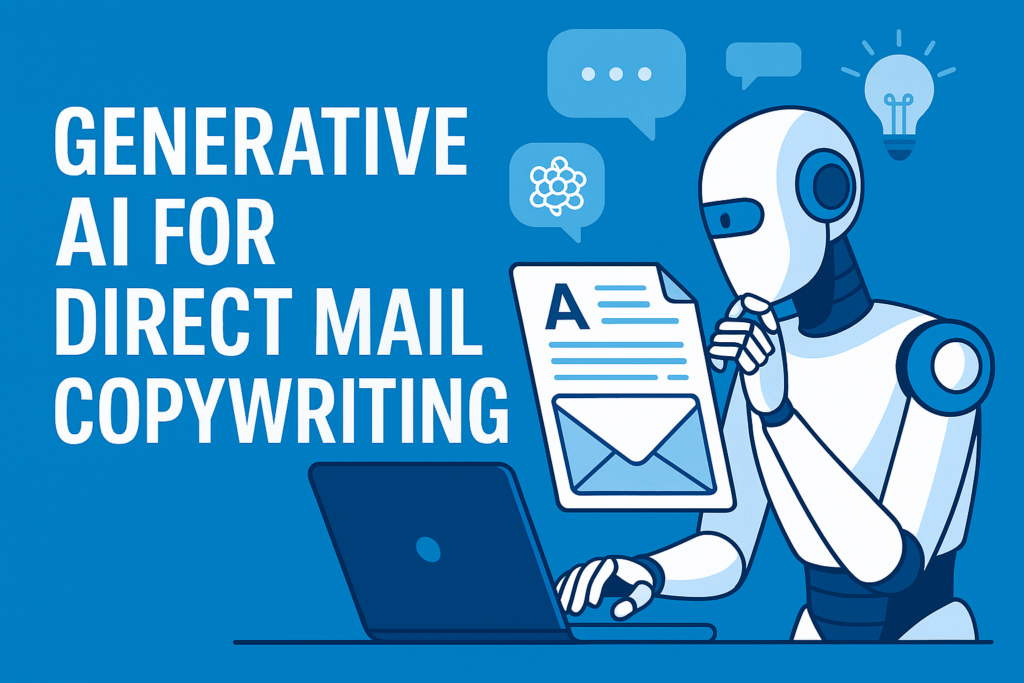
Do traditional direct mail copywriting frameworks still work in the AI era?
The most critical component in any successful marketing campaign is a great offer. Without it, you’ll have a hard time convincing anyone that you have something worth buying.
The second? Great copy. Without great copy, no one will know that you have a great offer.
“In the modern world of business, it is useless to be a creative, original thinker unless you can also sell what you create.”
David Ogilvy
Copywriting is about crafting words that sell. But in 2025, the rules have changed. AI has rewritten the playbook for creating persuasive direct mail copy, just as Postalytics has redefined direct mail automation.
Great copy does more than just inform, it creates an emotional connection with your ideal customers. It gives them two distinct paths — life with and without your product — and makes the choice clear.
Test Out Automated Direct Mail: Send a Sample
Crafting persuasive direct mail copy isn’t so easy. Or at least, it wasn’t until now. With AI tools and Postalytics’ automation, what used to take days now takes minutes. Even marketers with limited copywriting experience can produce compelling copy when armed with AI and a strong understanding of their customers and value proposition.
In this article, we’ll challenge old assumptions about direct mail copywriting and show you how AI is transforming this critical process. Let’s dive into 11 tips that will help you craft compelling and persuasive direct mail copy in the AI era.
#1) Supercharge Traditional Copywriting Formulas with AI
The best AI-enhanced copywriting doesn’t replace proven formulas—it supercharges them. Traditional frameworks still work, but now you can generate and test variations in minutes instead of days.
Before — After — Bridge (AI-Enhanced)
This formula helps readers build a story in their head—a story where their life changes because of their purchase of your product.
With AI tools, you can now generate multiple variations of each section in seconds, testing different emotional triggers and value propositions.
Let’s use a dentist example:
Before: “Crooked smile making you hide in photos?”
After: “Imagine confidently showing your perfect smile in every picture, job interview, and first date.”
Bridge: “Our AI-matched braces treatment provides a custom solution in half the time of traditional methods. Schedule your free consultation today.”
AI tools can help you identify which emotional triggers resonate most with your audience and refine your copy accordingly.
Problem, Agitate, Solve (AI-Optimized)
This formula is similar to “Before, After, Bridge” but focuses on showing prospects how their life will be if the problem persists.
AI excels at intensifying the “agitate” phase by drawing from vast datasets of customer pain points and emotional responses:
Problem: “Crooked teeth affecting your confidence?”
Agitate: “While you hesitate, you’re missing out on career opportunities, dating prospects, and countless moments where you held back your smile—all because you’re self-conscious about your teeth.”
Solve: “Our AI-designed treatment plan straightens teeth 30% faster than traditional methods. Schedule your free consultation today and start smiling with confidence.”
Clear, Concise, Compelling, Credible
This formula is a popular one, but is really less of a formula and more of a guideline for writing effective copy. The 4 C’s, as it is often called. Following these guidelines can help you to make sure that you touch every base.
In truth, the 4 C’s could be applied to any formula, but are important enough to stand on their own of a reminder of what we should try to achieve with our copy.
Attention, Interest, Desire, Action AI-Powered AIDA)
The most popular copywriting formula in the world is “Attention, Interest, Desire, and Action” — the path that most copywriting attempts to lead the customer down. This formula can be spotted in popular digital ads, radio ads, TV ads, etc. AIDA is a great fit for most marketing platforms, particularly when you have a limited amount of time (or space) to make a connection with the prospect, as is true in direct mail copy.
First, the goal is to get the reader’s attention. You want a compelling headline that draws them in and speaks to their biggest concerns. On average, 8 out of 10 readers will read the headline while only 2 out of ten will read the rest. Then, you keep their interest. Give them fresh and compelling information that connects to the points that you made in your headline.
Then, desire. What are the benefits of your product or service? Do you have proof that it can do what you say that it can? Then we ask them to take action — buy the product, fill out a form, request more information — whatever action you would like the reader to take.
With AI tools, you can now generate dozens of headline variations to test which ones capture attention most effectively. You can use data from your previous campaigns to inform the AI about what works best for your specific audience.
For example:
Attention: “AI Analysis Shows: Crooked Teeth Add 7 Years to Perceived Age”
Interest: “Our proprietary AI-matched treatment analyzes 217 points on your dental structure to create a custom plan that’s 43% faster than traditional braces—and you only wear it at night!”
Desire: “Join the 94% of our clients who report increased confidence in professional and social situations after treatment. [Client testimonials with before/after images]”
Action: “Scan the personalized QR code for your AI smile simulation and free consultation booking.”
These are just a few of the many popular copywriting formulas that you can use to help get the gears turning for your next direct mail campaign.
Now let’s dive into some tips that you can use to increase the effectiveness of your copy and improve conversion rates through direct mail.
#2) Let AI Work Backwards from Your Offer for Better Direct Mail Copy
Working in reverse has always been a great copywriting strategy. If you know the end goal, you can outline the steps that it would take for the customer to get to that point.
What’s changed? AI can now map every step of the customer journey in seconds, including potential objections and decision points.
For our braces example, AI can generate a comprehensive list of questions and concerns a prospect might have:
- Will these braces work for my specific dental issue?
- How quickly will I see results?
- How do they compare to Invisalign or traditional braces?
- Will my insurance cover this?
- How uncomfortable will they be?
- What happens if I’m not satisfied?
The AI can then help you address each concern in your copy, ensuring nothing is overlooked. This approach is radically more thorough than manual brainstorming and ensures your copy addresses the full spectrum of customer considerations
#3) Use AI to Focus on Benefits, Not Features
This is a common mistake in any marketing channel. As marketers, we can sometimes get too close to our own products. We fall in love with the features that our product delivers. We see things through that pane. But customers don’t. They see products and services in terms of how it is going to help them.
This isn’t just a copywriting tip anymore—it’s an area where AI excels. Good AI tools can instantly translate technical features into customer-focused benefits that resonate emotionally.
For example, instead of: “Our braces use advanced polymer materials with 24-point adjustment capability.”
AI might suggest: “Your smile transforms faster with braces that adjust to your unique needs, letting you feel confident sooner with less discomfort.”
AI can analyze your product features and customer data to identify which benefits will resonate most with specific segments of your audience, allowing for deeper personalization.
This isn’t to say that features aren’t always important. Sometimes, a feature can be a benefit when it directly solves a particular pain point for the customer.
For instance, maybe a customer had a bad experience with Invisalign braces. Maybe they found it to be bothersome that as their teeth straightened, they had to keep going back into the Dentist to have a new molding created. In this example, the fact that your braces are adjustable with a quick visit in just a few seconds is both a feature and a benefit.
#4) Let AI Identify and Use the Customer’s Pain Points
AI doesn’t just identify pain points—it prioritizes them based on emotional intensity and conversion potential. By analyzing thousands of customer interactions, reviews, and social media posts, AI can determine which pain points drive purchase decisions most effectively.
For braces, AI might determine that while health concerns matter, emotional and social pain points drive faster conversions:
- Primary pain point: Feeling judged in professional settings due to crooked teeth
- Secondary: Discomfort while eating
- Tertiary: Long-term dental health concerns
This data-driven approach ensures your copy targets the most motivating pain points rather than what you assume matters most to customers.
Your direct mail copy should zero in on a single pain point (or at most a few specific pain points) that you can solve for the customer. Key in on what it is that is driving them mad. The reasons that they sought out a product like yours in the first place.
#5) The Deeper the Personalization in Direct Mail Copy, the Better
80% of shoppers are more likely to buy from companies that personalize their experience. But with AI, personalization goes far beyond merely inserting the recipient’s name.
AI can now analyze customer behavior patterns to personalize messaging, offers, and even design elements based on individual preferences. This isn’t just about knowing their name—it’s about knowing their motivations.
At Postalytics, deep personalization is baked into everything we do. Our platform allows you to seamlessly integrate AI-driven personalization into your campaigns, creating truly individualized experiences at scale:
- Personalized imagery based on demographic data
- Customized offers based on previous interactions
- Adaptive messaging that reflects their specific pain points
- Variable QR codes that lead to personalized landing pages
#6) Train AI to Answer Objections Preemptively
Look at copy as sales in written form. During any sales conversation, one of the main jobs of any sales rep is to handle objections and present alternative scenarios where those objections are proved to be untrue.
AI can now predict objections before they arise by analyzing patterns from thousands of customer interactions. This allows you to address concerns in your copy that prospects might not even consciously recognize yet.
The five common sales objections still exist:
- I don’t have enough time.
- I don’t have enough money.
- It won’t work for me.
- I don’t believe you.
- I don’t need it.
But AI tools can now help you identify which objections are most relevant to your specific offer and audience segment, then generate persuasive counter-arguments tailored to your brand voice.
For instance, AI might determine that for your dental practice, the strongest objection is “I don’t believe you,” suggesting you include before/after imagery, specific data points on success rates, and authentic testimonials to build credibility.
Figure out which objections are most relevant to you and your product. You’ll likely have a good idea of which objections are most common with your customers. Then, you can prioritize those objections in your copy.
#7) AI Helps Maintain “You” Focus, not “We” Focus
In copy, you are writing for the customer. Frame everything in terms of what it would do for them. When you find yourself saying things like “Our product,” “Our platform,” or “Our company,” too much, there is a good chance that you are writing for the wrong audience.
This principle remains crucial, but now AI can help ensure your copy stays customer-focused throughout. AI writing tools can scan your copy and flag instances where you’ve shifted from “you” language to company-centric messaging.
Most AI writing assistants can be trained to prioritize second-person perspective and highlight areas where your copy has drifted into talking about your company instead of the customer’s needs.
Some tools even provide specific suggestions for rewording sentences to maintain the customer focus, turning: “We offer comprehensive orthodontic evaluations” into: “You’ll receive a comprehensive assessment of your smile, revealing options you may never have considered possible.“
A focus on benefits naturally leads to a focus on your customer and framing everything in terms of how it will help them to solve problems and achieve goals.
#8) Prioritize Readability
You want to write your copy like you expected a fifth grader to read it. Simple words, short sentences. Make sure that you leave plenty of room between paragraphs and white space in your design as a whole.
Let your direct mail copy breathe!
You want headlines and important points to stand out on the page. A great tool for assessing the readability of any writing is Hemingway App. It’s a free tool that analyzes your writing, pinpoint problematic sentences, and helps you to improve readability.
This study from the Nielsen Norman Group found that readers tend to read content in an F-shaped pattern — skimming headlines and opening paragraph sentences, deep-diving only into the portions that they find the most compelling. You can expect your readers to treat your copy in the same way. Take extra care in crafting your headlines and opening sentences to give yourself the best chance of drawing your readers into your ads.
Modern AI tools go beyond basic readability scoring to analyze how your audience will visually process your direct mail piece. They can now predict eye movement patterns and attention hotspots, helping you design layouts that guide readers naturally through your message.
AI readability tools can:
- Adjust sentence complexity based on your target demographic
- Recommend optimal paragraph length for maximum engagement
- Suggest strategic placement of visual elements and calls to action
- Identify where readers are likely to disengage and recommend fixes
#9) Use AI to Find the Perfect Balance of Technical Details
While benefits remain king, AI can help you determine exactly how much technical detail to include for maximum credibility without overwhelming your reader.
AI can analyze your audience’s technical sophistication and adjust accordingly, introducing just enough technical information to build trust without crossing into information overload.
For instance, AI might suggest including the specific patented material in your braces for a technically-minded audience, while focusing on comfort and results for a general consumer audience.
The level of detail should still be guided by your direct mail format. AI can help you optimize copy density based on whether you’re using a 4×6 postcard or a multi-page letter.
#10) Create a Truly Attention-Grabbing Call to Action
The only part of your copy that may rival the headline in terms of importance is a call to action. Your call to action must push the reader toward the desired action that you want to take.
Now AI can help test and optimize CTAs based on actual conversion data. Using AI, you can generate dozens of CTA variations and predict which will perform best before even sending your campaign.
AI tools can analyze successful CTAs across industries and adapt winning formulas to your specific offer. The best CTAs still:
- Reduce risk — Free, Money Back Guarantee, Cancel Anytime
- Tell the recipient what to do next — Go To This Web Page, Scan This Code, Call Now
- Create a sense of urgency — Now, Hurry, Limited Time Offer
AI can help you combine these elements in the most effective way for your specific audience and offer.
Every piece of content that you deliver should call your readership to action in some meaningful way, whether that means buying your product, booking a call, or simply requesting further information.
Don’t bury your call to action with a small font, or competing visual elements. We recommend using visual cues to draw the eye toward the call to action.

#11) Recycle What Works
Use successful campaigns to guide the way that you write copy in future campaigns. When you find copy that connects with your customers, save it. Even if it’s just general ideas — benefits highlighted, product details included, objections answered — copy that is proven successful with your audience is worth its weight in gold.
Effective Direct Mail Copy Drives Successful Campaigns—AI Makes It Happen Faster
At the heart of every successful direct mail campaign is effective copywriting. What used to take days or weeks of creative effort can now be accomplished in minutes with AI tools—but the fundamental principles remain the same.
Great copy communicates with your customers and prospects, providing them with the details that matter most and guiding them through evaluating your offer. AI simply makes this process faster, more data-driven, and ultimately more effective.
Postalytics has redefined direct mail by making it as fast and measurable as email marketing. Now, AI is doing the same for copywriting—challenging old assumptions about how long it takes to create compelling direct mail copy.
About the Author

Dennis Kelly
Dennis Kelly is CEO and co-founder of Postalytics, the leading direct mail automation platform for marketers to build, deploy and manage direct mail marketing campaigns. Postalytics is Dennis’ 6th startup. He has been involved in starting and growing early-stage technology ventures for over 30 years and has held senior management roles at a diverse set of large technology firms including Computer Associates, Palm Inc. and Achieve Healthcare Information Systems.
